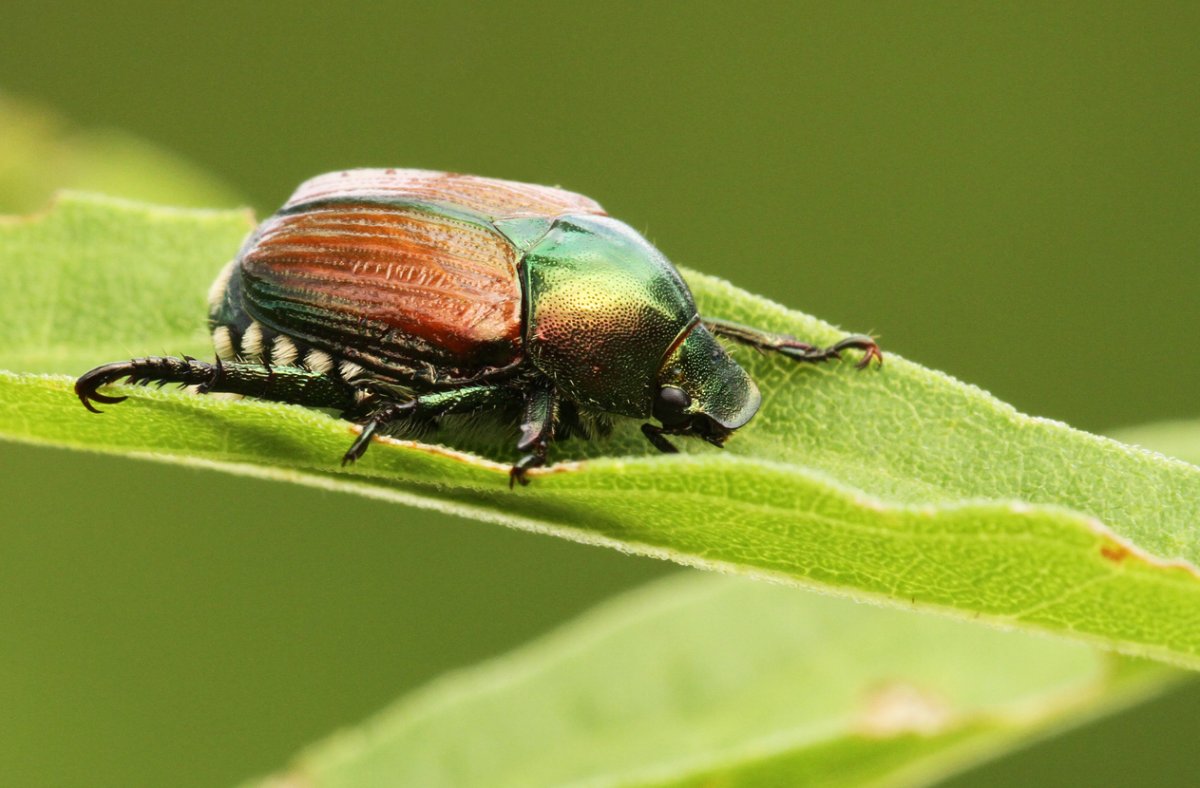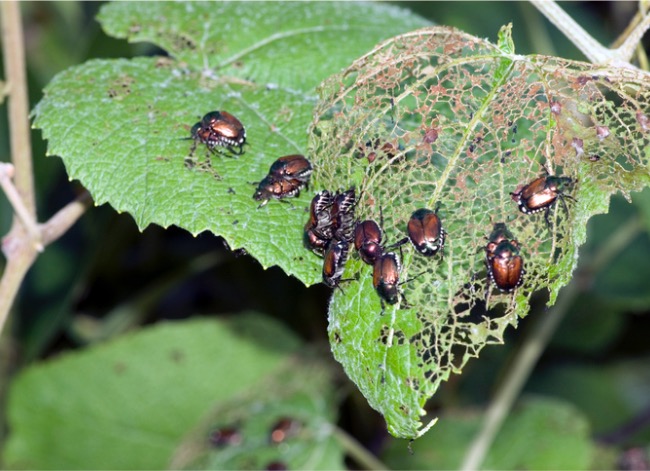

We may earn revenue from the products available on this page and participate in affiliate programs. Learn More ›
Japanese beetles might be harmless to humans but that doesn’t mean you want them around. This invasive insect feeds on more than 300 plants and costs the United States more than $460 million a year to manage, according to Penn State Extension. They’ll eat through plant leaves and even flowers.
As their name implies, these insects are native to Japan but now are found in much of the United States. Adults have a distinct metallic green or bronze color on their backside. They are about 13 mm (½ inch) long with copper-colored front wings. If you find one Japanese beetle, you’ll find more. But there are some simple things you can do. We’ll show you how to get rid of Japanese beetles with a few different strategies.
Essential Gear

The Catchmaster Japanese Beetle Traps (3-pack) offer an effective, pesticide-free way to protect your garden from destructive beetles. Each trap covers 5,000 square feet and should last a whole season, so this multi-pack will cover substantial ground and keep infestations in check without breaking the bank.
Get the 3-pack of Catchmaster Japanese Beetle Traps at Amazon for $34.99.
Before You Begin
It’s best to prevent or get rid of Japanese beetles as soon as you can. Once their numbers grow, it becomes more difficult to eradicate them. Because these beetles are drawn to the scent of ripening or diseased fruits, monitoring your plants carefully and picking fruits and veggies promptly are two of the best ways to keep them at bay.
Signs of Japanese Beetle Infestation

Japanese beetles love munching on a variety of plants, and will feed on every part: fruits and flowers, leaves, even the roots. These pests tend to prefer fruit-producing plants such as raspberries, grapes, apples, cherries, and plums. They will happily feast on trees like elm and birch, and they simply love roses.
Adult female Japanese beetles will lay eggs 2 to 3 inches down into the soil. There, grubs will chew on plant roots for nutrients before they emerge as adults.
How can you tell if you have grubs, eggs, or adult beetles? Take a good look at the leaves of your trees, shrubs and plants. One of the telltale signs of a Japanese beetle infestation is skeletonized leaves. The insects feed on the areas between major veins, which give the leaves a lacy or skeleton-like appearance. Depending on the plant, the leaves might also die and fall off. You may notice dead patches of grass where Japanese beetle grubs have destroyed the root systems.
It’s important to note that Japanese beetles tend to be found in groups. If you see one on your plant, you likely have several more.
RELATED: 12 of the Most Common Garden Pests—Including 8 of the Most Destructive Bugs
Protect Pollinators by Using Natural Methods for Japanese Beetles Removal
While you might be tempted to get rid of Japanese beetles quickly by dousing them with harsh chemical pesticides, opting for organic and natural remedies is the best way to protect pollinators.
Pollinators such as bees, butterflies, birds, and bats play an important role in the health of the ecosystem because they plant pollen grains, which results in fruit and seeds. In fact, 80 percent of the world’s flowering plants need help from pollinators, according to the U.S. Forest Service.
“Application of insecticides to control pests including Japanese beetles should be considered the last resort,” advises the University of Missouri Integrated Pet Management program. “When exploring chemical control options, farmers/gardeners should select the lowest risk and the most effective products.”
How to Get Rid of Japanese Beetles
Japanese beetles, like certain other insects, can be a major nuisance in your lawn and garden. Since they are not native to the United States, they have few natural enemies. If you find yourself with a Japanese beetle infestation in your yard or garden, try one or more of the following methods.
1. Set beetle traps away from targeted plants.

Japanese beetle traps are a great way to stop an infestation of these pests from getting worse. Traps work by luring male beetles away from the affected areas before they can mate.
There are various traps available for purchase, but the main idea is that the trap contains some kind of attractant such as a pheromone (chemical messenger) to lure insects to the trap. The insects are then either exterminated by a toxicant, or die because they cannot escape the trap.
2. Make a homemade Japanese beetle spray.
A simple solution of water and dish soap can suffocate Japanese beetles. Grab a bucket and mix a quart of water with a teaspoon of dish soap. Once you mix the water with dish soap, the least “touchy” solution is to pour the soapy water into a spray bottle and spray the beetles on your affected plants. This can cause the beetles to drop from the plant and possibly become food for predators such as birds.
3. Pick the Japanese beetles off plants by hand.
One of the easiest ways to get rid of Japanese beetles is picking them off by hand. The insects don’t move quickly, nor do they bite or pinch, so you can just go to town on those little pests with your fingers (wearing thin gardening gloves, if you prefer). Once you pick a beetle off the plant, drop it in a bucket filled with the soap-and-water solution.
4. Spray the affected plants with neem oil.
Neem oil will kill Japanese beetles before they become adults. Since neem oil is nontoxic, you can spray it right on your affected plants.
Here’s how it works: When male beetles ingest neem oil, they pass it on to the eggs. Then, the hatched Japanese beetle larvae will eventually die before they become adults. The best way to kill Japanese beetles with neem oil is to spray the oil before the beetles enter their adult stage so they’ll ingest it before mating.
5. Use row covers during peak feeding period.
A row cover might be the best solution to stopping a Japanese beetle infestation before it gets started. Row covers provide protection by keeping Japanese beetles out, but are still fine enough to let in light and some moisture, allowing the plants to continue to grow.
Row covers are best used during peak feeding periods for the beetles, which generally run from mid-June to mid-August. The covers come in different sizes and can be used on shrubs or trees or placed over your flowers, ornamental plants, or garden vegetables.
6. Bring in parasitic nematodes to eat Japanese beetle grubs.
Nematodes are a type of parasitic roundworm that can live in a variety of environments and feed on everything from plants and bacteria to humans and animals. In the fight against Japanese beetles, certain nematodes can be used to control the pest in its grub stage.
Two genera of parasitic nematodes have been most actively considered for controlling Japanese beetles and other insect pests: Steinernema and Heterorhabditis, although only Heterorhabditis is commercially available. These beneficial insects can be purchased at most garden stores and online, and are usually sold in a container that can be kept in cool conditions for up to 2 months. Just follow instructions on the package, and apply with any insecticide applicator.
7. Plant geraniums near the plants you want to protect.

Another way to control Japanese beetles is adding a particular plant to your garden. Scientists say geraniums are a natural way to help keep these pesky insects from destroying other nearby plants.
The U.S. Department of Agriculture reports that “within 30 minutes of consuming geranium petals, the beetle rolls over on its back, its legs and antennae slowly twitch, and it remains paralyzed for several hours. The beetles typically recover within 24 hours, but they often succumb to death after predators spot and devour the beetles while they are helpless.”
8. Prune rose buds and treat rose bushes before they bloom.
A good way to prevent Japanese beetles from decimating your prized rose bushes is to prune any rose buds and treat bushes before they bloom.
After the season’s first flush, try pruning the roses back a bit further than normal. Doing so may help make sure any beetles hanging around will be gone before the flowers flush again. When you’re done pruning, remove any few remaining beetles by hand.
In addition, you can always cover your rose bushes with mesh plant netting (found at most gardening stores) or spray any affected plants with neem oil to prevent lingering grubs from becoming adults.
9. Avoid grouping plants that attract Japanese beetles together in your garden.
Japanese beetles love certain plants. “Research has also shown that natural sugar content and presence of odoriferous substances are important factors in determining the susceptibility of plants to attack by Japanese beetle adults. For example, plants with higher amounts of the reducing sugar dextrose suffer greater damage from adult beetles than plants with lower amounts of dextrose,” according to the University of Illinois Extension office.
Thus, one way to prevent Japanese beetles is to avoid grouping plants that attract this invasive pest. Highly susceptible plants you should avoid grouping include both Japanese and Norway maple, birch, crabapple, cherry, raspberry, rose, plum, and grapes.
Final Thoughts
Even though Japanese beetles are harmless to humans, they can leave a trail or destruction behind when it comes to the plants and trees in your yard and garden.
While it’s best to stop an infestation of these invasive pests early, some tried-and-true methods to get rid of these invasive pests when they show up include removing them by hand, using a homemade soap-and-water solution that will suffocate them, spray affected plants with neem oil, and use beetle traps. In addition, being proactive can help cut down on any infestations. Avoid grouping susceptible plants in groups, keep rose buds pruned, and try introducing parasitic nematodes to your landscape to eat away at Japanese beetle grubs.
FAQs
Japanese beetles are approximately ⅓ to ½ inch long and they have a metallic green head with copper-brown wing covers. In addition, if you look at their abdomen, they’ll have white patches of hair. When it comes to larvae, they’ll be C-shaped with a white- to cream-colored body and a tan-colored head.
Japanese beetles feed on about 300 species of plants. While a single beetle doesn’t eat much, they tend to feed in groups and can eat away at an entire plant, causing severe damage. They’ll devour everything from flowers and fruit to leaves and stems.
Japanese beetles are harmless to humans and pets. These pests do have rough spines on their legs that might feel prickly if you get one on your skin, but they do not bite. It’s your plants and shrubs that you should be concerned about.
The Japanese beetle lifecycle begins in the soil, where they’ll start as grubs and develop for 10 months before becoming full sized. From there they’ll emerge as adults and live for 30 to 45 days before dying.
Japanese beetles lay their eggs in the soil, about 2 to 3 inches down. Females will lay up to 60 eggs during their lifetime. It will take about 10 months for a Japanese beetle egg to develop before it emerges as an adult.
